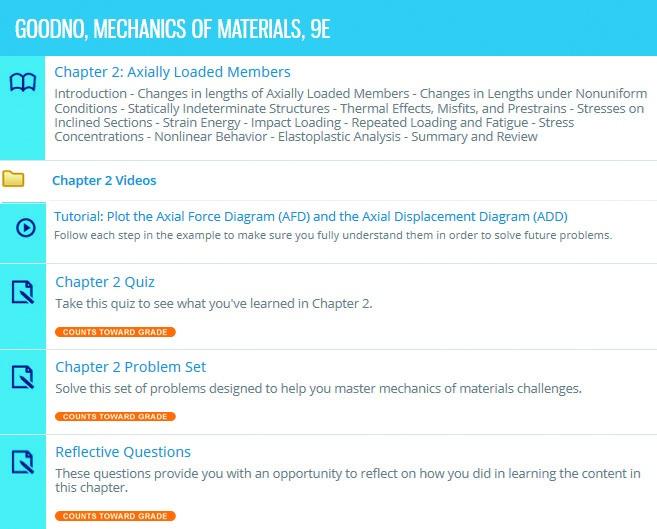Mechanics of Materials 9th Edition
Visit to download the full and correct content document: https://ebookmass.com/product/mechanics-of-materials-9th-edition/
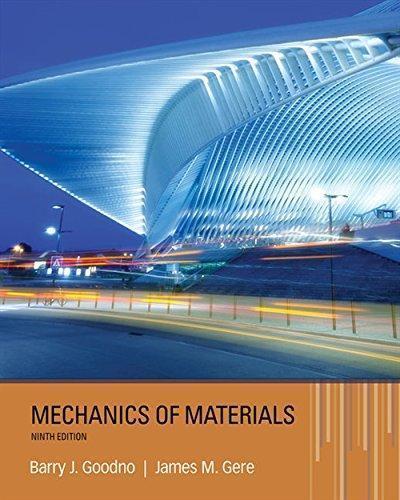
More products digital (pdf, epub, mobi) instant download maybe you interests ...
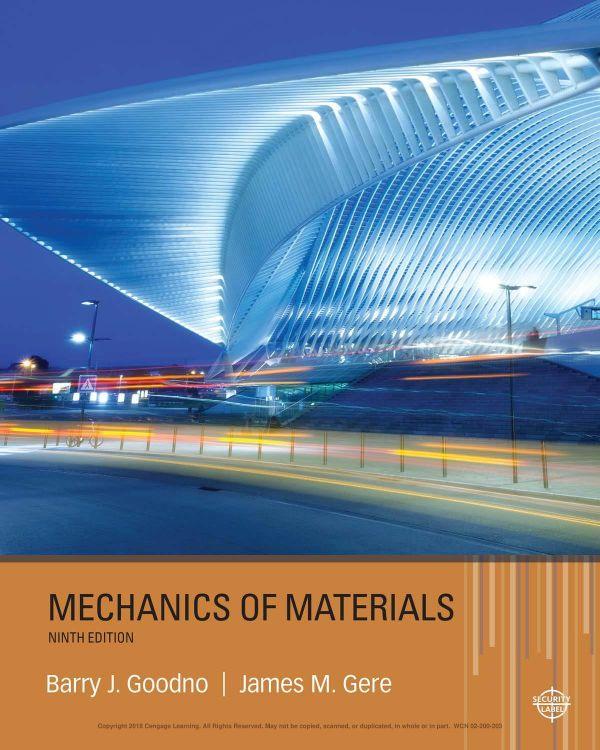
Mechanics of Materials 9th Edition Barry J. Goodno
https://ebookmass.com/product/mechanics-of-materials-9th-editionbarry-j-goodno/
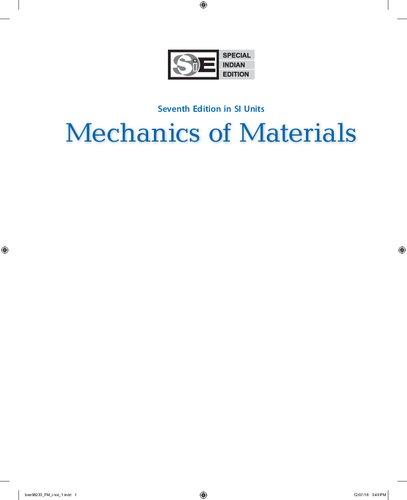
Mechanics Of Materials 7th Edition Beer
https://ebookmass.com/product/mechanics-of-materials-7th-editionbeer/
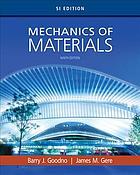
Mechanics of materials Ninth Edition, Si. Edition Gere
https://ebookmass.com/product/mechanics-of-materials-ninthedition-si-edition-gere/
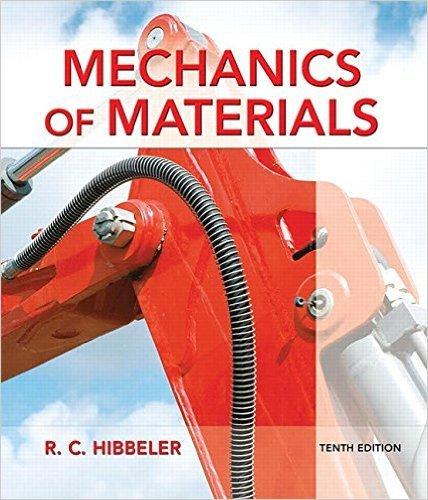
eTextbook 978-0134319650 Mechanics of Materials (10th Edition)
https://ebookmass.com/product/etextbook-978-0134319650-mechanicsof-materials-10th-edition/
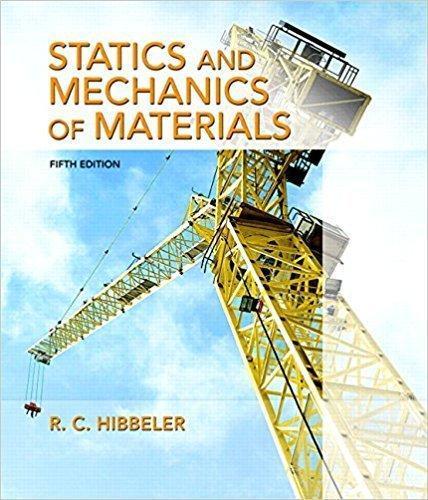
Statics and Mechanics of Materials (5th Edition ) 5th Edition
https://ebookmass.com/product/statics-and-mechanics-ofmaterials-5th-edition-5th-edition/
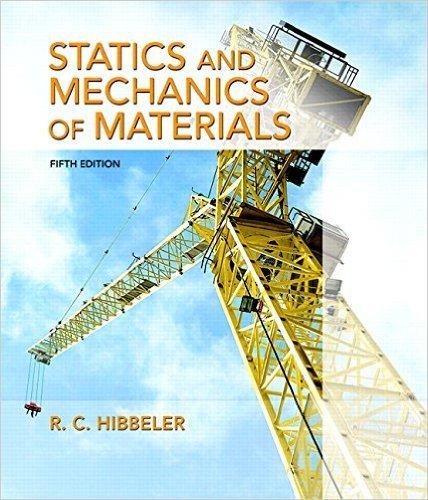
eTextbook 978-0134382593 Statics and Mechanics of Materials (5th Edition)
https://ebookmass.com/product/etextbook-978-0134382593-staticsand-mechanics-of-materials-5th-edition/
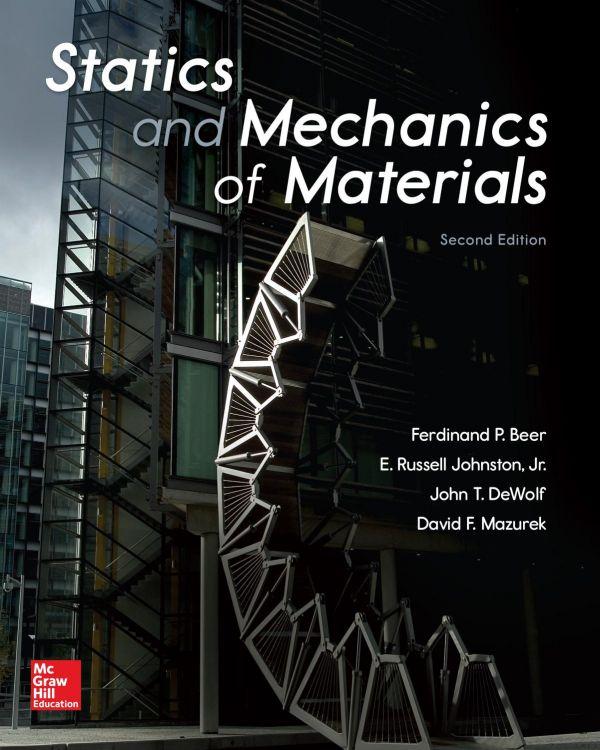
Statics and Mechanics of Materials 2nd Edition
Ferdinand P. Beer
https://ebookmass.com/product/statics-and-mechanics-ofmaterials-2nd-edition-ferdinand-p-beer/
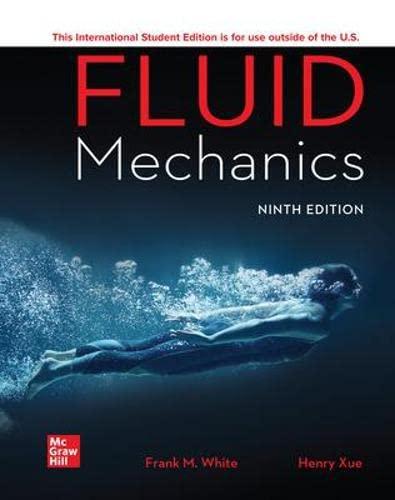
Fluid Mechanics (9th Edition) Frank M. White
https://ebookmass.com/product/fluid-mechanics-9th-edition-frankm-white/

Munson, Young and Okiishi's Fundamentals of Fluid Mechanics 9th Edition Philip M. Gerhart
https://ebookmass.com/product/munson-young-and-okiishisfundamentals-of-fluid-mechanics-9th-edition-philip-m-gerhart/
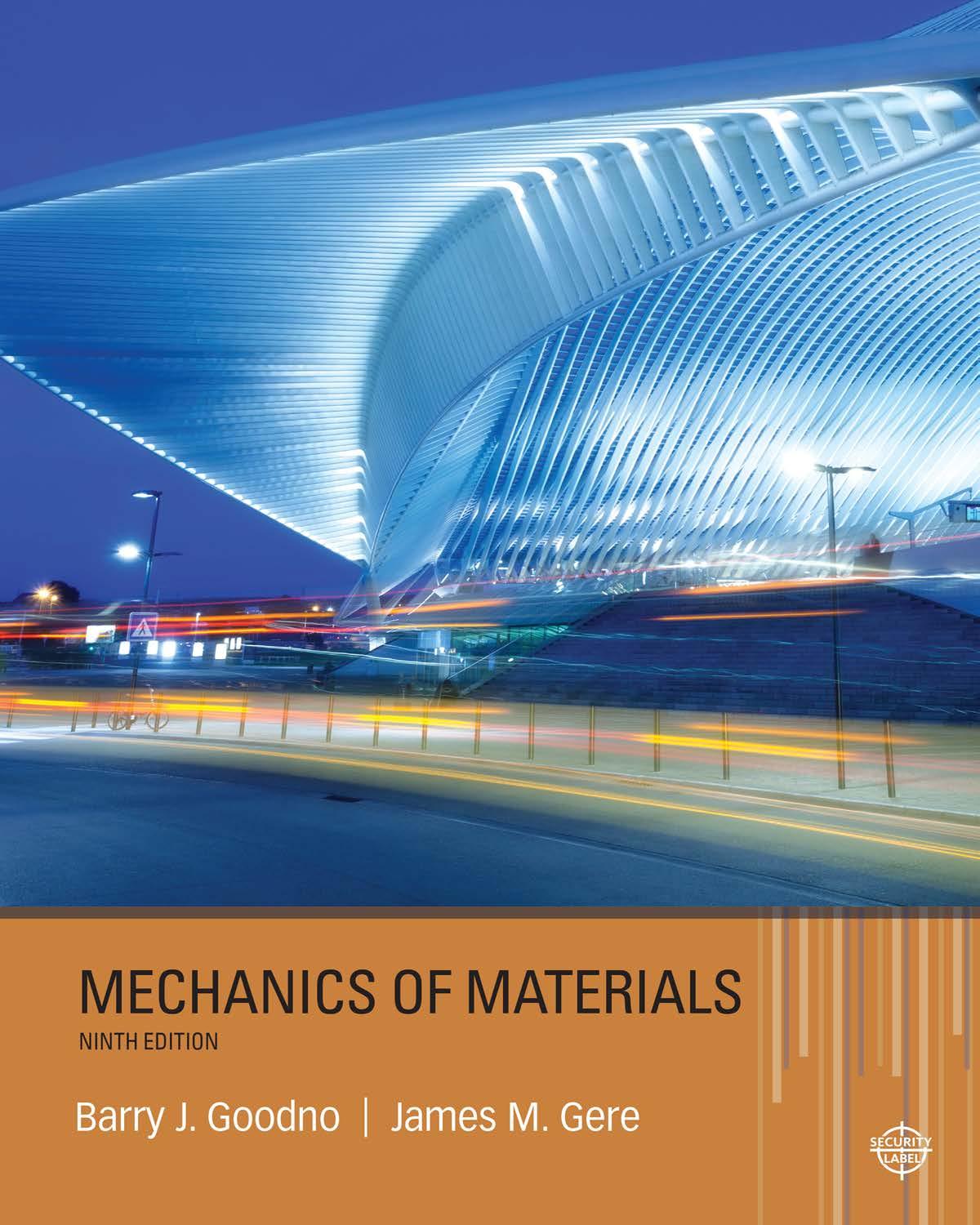
5.4 Longitudinal Strains in Beams 449
5.5 Normal Stress in Beams (Linearly Elastic Materials) 453
5.6 Design of Beams for Bending Stresses 466
5.7 Nonprismatic Beams 476
5.8 Shear Stresses in Beams of Rectangular Cross Section 480
5.9 Shear Stresses in Beams of Circular Cross Section 488
5.10 Shear Stresses in the Webs of Beams with Flanges 491
*5.11 Built-Up Beams and Shear Flow 498
*5.12 Beams with Axial Loads 502
*5.13 Stress Concentrations in Bending 509
Chapter Summary and Review 514 Problems 518
6. Stresses in Beams (Advanced Topics) 553
6.1 Introduction 554
6.2 Composite Beams 554
6.3 Transformed-Section Method 563
6.4 Doubly Symmetric Beams with Inclined Loads 571
6.5 Bending of Unsymmetric Beams 578
6.6 The Shear-Center Concept 589
6.7 Shear Stresses in Beams of Thin-Walled Open Cross Sections 590
6.8 Shear Stresses in Wide-Flange Beams 593
6.9 Shear Centers of Thin-Walled Open Sections 597
*6.10 Elastoplastic Bending 605
Chapter Summary and Review 614 Problems 616
7. Analysis of Stress and Strain 639
7.1 Introduction 640
7.2 Plane Stress 640
7.3 Principal Stresses and Maximum Shear Stresses 648
7.4 Mohr’s Circle for Plane Stress 656
7.5 Hooke’s Law for Plane Stress 669
7.6 Triaxial Stress 675
7.7 Plane Strain 679
Chapter Summary and Review 694
Problems 697
8. Applications of Plane Stress
(Pressure Vessels, Beams, and Combined Loadings) 719
8.1 Introduction 720
8.2 Spherical Pressure Vessels 720
8.3 Cylindrical Pressure Vessels 726
8.4 Maximum Stresses in Beams 733
8.5 Combined Loadings 741
Chapter Summary and Review 766
Problems 768
9. Deflections of Beams 787
9.1 Introduction 788
9.2 Differential Equations of the Deflection Curve 788
9.3 Deflections by Integration of the Bending-Moment Equation 793
9.4 Deflections by Integration of the ShearForce and Load Equations 804
9.5 Method of Superposition 809
9.6 Moment-Area Method 818
9.7 Nonprismatic Beams 826
9.8 Strain Energy of Bending 831
*9.9 Castigliano’s Theorem 836
*9.10 Deflections Produced by Impact 848
*9.11 Temperature Effects 850
Chapter Summary and Review 854 Problems 856
10. Statically Indeterminate Beams
883
10.1 Introduction 884
10.2 Types of Statically Indeterminate Beams 884
10.3 Analysis by the Differential Equations of the Deflection Curve 887
10.4 Method of Superposition 893
*10.5 Temperature Effects 907
*10.6 Longitudinal Displacements at the Ends of a Beam 914 Chapter Summary and Review 917 Problems 919
11. Columns 933
11.1 Introduction 934
11.2 Buckling and Stability 934
11.3 Columns with Pinned Ends 942
11.4 Columns with Other Support Conditions 951
11.5 Columns with Eccentric Axial Loads 960
11.6 The Secant Formula for Columns 965
11.7 Elastic and Inelastic Column Behavior 970
11.8 Inelastic Buckling 972
11.9 Design Formulas for Columns 977 Chapter Summary and Review 993 Problems 996
References and Historical notes 1019
APPenDIX A: Systems of Units and Conversion Factors 1029
APPenDIX B: Problem Solving 1043
APPenDIX C: Mathematical Formulas 1051
APPenDIX D: Review of Centroids and Moments of Inertia 1057
APPenDIX e: Properties of Plane Areas 1083
APPenDIX F: Properties of Structural-Steel Shapes 1089
APPenDIX G: Properties of Structural Lumber 1101
APPenDIX H: Deflections and Slopes of Beams 1103
APPenDIX I: Properties of Materials 1109 Answers to Problems 1115 Index 1153

Barry J. Goodno
Barry John Goodno is Professor of Civil and Environmental Engineering at Georgia Institute of Technology. He joined the Georgia Tech faculty in 1974. He was an Evans Scholar and received a B.S. in Civil Engineering from the University of Wisconsin, Madison, Wisconsin, in 1970. He received M.S. and Ph.D. degrees in Structural Engineering from Stanford University, Stanford, California, in 1971 and 1975, respectively. He holds a professional engineering license (PE) in Georgia, is a Distinguished Member of ASCE and an Inaugural Fellow of SEI, and has held numerous leadership positions within ASCE. He is a past president of the ASCE Structural Engineering Institute (SEI) Board of Governors and is also a member of the Engineering Mechanics Institute (EMI) of ASCE. He is past-chair of the ASCE-SEI Technical Activities Division (TAD) Executive Committee, and past-chair of the ASCE-SEI Awards Committee. In 2002, Dr. Goodno received the SEI Dennis L. Tewksbury Award for outstanding service to ASCE-SEI. He received the departmental award for Leadership in Use of Technology in 2013 for his pioneering use of lecture capture technologies in undergraduate statics and mechanics of materials courses at Georgia Tech. He is a member of the Earthquake Engineering Research Institute (EERI) and has held several leadership positions within the NSF-funded Mid-America Earthquake Center (MAE), directing the MAE Memphis Test Bed Project. Dr. Goodno has carried out research, taught graduate courses and published extensively in the areas of earthquake engineering and structural dynamics during his tenure at Georgia Tech.
Dr. Goodno is an active cyclist, retired soccer coach and referee, and a retired marathon runner. Like co-author and mentor James Gere, he has completed numerous marathons including qualifying for and running the Boston Marathon in 1987.
James M. Gere
James M. Gere (1925-2008) earned his undergraduate and master’s degree in Civil Engineering from the Rensselaer Polytechnic Institute in 1949 and 1951, respectively. He worked as an instructor and later as a Research Associate for Rensselaer. He was awarded one of the first NSF Fellowships, and chose to study at Stanford. He received his Ph.D. in 1954 and was offered a faculty position in Civil Engineering, beginning a 34-year career of engaging his students in challenging topics in mechanics, and structural and earthquake engineering. He served as Department Chair and Associate Dean of Engineering and in 1974 co-founded the John A. Blume Earthquake Engineering Center at Stanford. In 1980, Jim Gere also became the founding head of the Stanford Committee on Earthquake Preparedness. That same year, he was invited as one of the first foreigners to study the earthquake-devastated city of Tangshan, China. Jim retired from Stanford in 1988 but continued to be an active and most valuable member of the Stanford community.
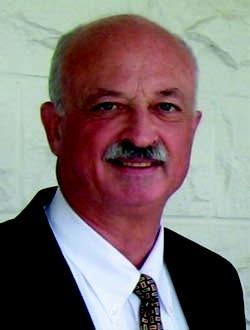
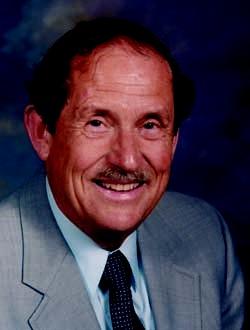
Courtesy of James and Janice Gere Family Trust
Jim Gere was known for his outgoing manner, his cheerful personality and wonderful smile, his athleticism, and his skill as an educator in Civil Engineering. He authored nine textbooks on various engineering subjects starting in 1972 with Mechanics of Materials, a text that was inspired by his teacher and mentor Stephan P. Timoshenko. His other well-known textbooks, used in engineering courses around the world, include: Theory of Elastic Stability, co-authored with S. Timoshenko; Matrix Analysis of Framed Structures and Matrix Algebra for Engineers, both co-authored with W. Weaver; Moment Distribution; Earthquake Tables: Structural and Construction Design Manual, co-authored with H. Krawinkler; and Terra Non Firma: Understanding and Preparing for Earthquakes, co-authored with H. Shah.
In 1986 he hiked to the base camp of Mount Everest, saving the life of a companion on the trip. James was an active runner and completed the Boston Marathon at age 48, in a time of 3:13. James Gere will be long remembered by all who knew him as a considerate and loving man whose upbeat good humor made aspects of daily life or work easier to bear.
Mechanics of Materials is a basic engineering subject that, along with statics, must be understood by anyone concerned with the strength and physical performance of structures, whether those structures are man-made or natural. At the college level, statics is usually taught during the sophomore or junior year and is a prerequisite for the follow-on course in Mechanics of Materials. Both courses are required for most students majoring in mechanical, structural, civil, biomedical, petroleum, nuclear, aeronautical, and aerospace engineering. In addition, many students from such diverse fields as materials science, industrial engineering, architecture, and agricultural engineering also find it useful to study mechanics of materials.
Mechanics of Materials
In many university engineering programs today, both statics and mechanics of materials are taught in large sections of students from the many engineering disciplines. Instructors for the various parallel sections must cover the same material, and all of the major topics must be presented so that students are well prepared for the more advanced courses required by their specific degree programs. An essential prerequisite for success in a first course in mechanics of materials is a strong foundation in statics, which includes not only understanding fundamental concepts but also proficiency in applying the laws of static equilibrium to solutions of both two- and three-dimensional problems. This ninth edition begins with an updated section on statics in which the laws of equilibrium and an expanded list of boundary (or support) conditions are reviewed, as well as types of applied forces and internal stress resultants, all based upon and derived from a properly drawn free-body diagram. Numerous examples and endof-chapter problems are included to help students review the analysis of plane and space trusses, shafts in torsion, beams and plane and space frames, and to reinforce basic concepts learned in the prerequisite course.
Many instructors like to present the basic theory of say, beam bending, and then use real world examples to motivate student interest in the subject of beam flexure, beam design, etc. In many cases, structures on campus offer easy access to beams, frames, and bolted connections that can be dissected in lecture or in homework problems, to find reactions at supports, forces and moments in members and stresses in connections. In addition, study of causes of failures in structures and components also offers the opportunity for students to begin the process of learning from actual designs and past engineering mistakes. A number of the new example problems and also the new and revised end-of-chapter problems in this ninth edition are based upon actual components or structures and are accompanied by photographs so that the student can see the real world problem alongside the simplified mechanics model and free-body diagrams used in its analysis.
An increasing number of universities are using rich media lecture (and/ or classroom) capture software (such as Panopto and Tegrity) in their large undergraduate courses in mathematics, physics, and engineering. The many new photos and enhanced graphics in the ninth edition are designed to support this enhanced lecture mode.
Key Features
The main topics covered in this book are the analysis and design of structural members subjected to tension, compression, torsion, and bending, including the fundamental concepts mentioned above. Other important topics are the transformations of stress and strain, combined loadings and combined stress, deflections of beams, and stability of columns. Some additional specialized topics include the following: stress concentrations, dynamic and impact loadings, non-prismatic members, shear centers, bending of beams of two materials (or composite beams), bending of unsymmetric beams, maximum stresses in beams, energy based approaches for computing deflections of beams, and statically indeterminate beams.
Each chapter begins with a Chapter Overview highlighting the major topics covered in that chapter and closes with a Chapter Summary and Review in which the key points as well as major mathematical formulas in the chapter are listed for quick review. Each chapter also opens with a photograph of a component or structure that illustrates the key concepts discussed in the chapter.
new Features
Some of the notable features of this ninth edition, which have been added as new or updated material to meet the needs of a modern course in mechanics of materials, are:
• Problem-Solving Approach—All examples in the text are presented in a new Four-Step Problem-Solving Approach which is patterned after that presented by R. Serway and J. Jewett in Principles of Physics, 5e, Cengage Learning, 2013. This new structured format helps students refine their problem-solving skills and improve their understanding of the main concepts illustrated in the example.
• Statics Review—The Statics Review section has been enhanced in Chapter 1. Section 1.2 includes four new example problems which illustrate calculation of support reactions and internal stress resultants for truss, beam, circular shaft and plane frame structures. Thirty-four end-of-chapter problems on statics provide students with two- and three-dimensional structures to be used as practice, review, and homework assignment problems of varying difficulty.
• Expanded Chapter Overview and Chapter Summary and Review sections The Chapter Overview and Chapter Summary sections have been expanded to include key equations and gures presented in each chapter. These summary sections serve as a convenient review for students of key topics and equations presented in each chapter.
• Continued emphasis on underlying fundamental concepts such as equilibrium, constitutive, and strain-displacement/ compatibility equations in problem solutions. Example problem and end-of-chapter problem solutions have been updated to emphasize an orderly process of explicitly writing out the equilibrium, constitutive and strain-displacement/ compatibility equations before attempting a solution.
• Expanded topic coverage—The following topics have been updated or have received expanded coverage: stress concentrations in axially loads bars (Sec. 2.10); torsion of noncircular shafts (Sec. 3.10); stress concentrations in bending (Sec. 5.13); transformed section analysis for composite beams (Sec. 6.3); generalized flexure formula for unsymmetric beams (Sec. 6.5); and updated code provisions for buckling of steel, aluminum and timber columns (Sec. 11.9).
• Many new example and end-of-chapter problems—More than forty new example problems have been added to the ninth edition. In addition, there are more than 400 new and revised end-of-chapter problems out of the 1440 problems presented in the ninth edition text. The end-of-chapter problems are now grouped as Introductory or Representative and are arranged in order of increasing difficulty.
• Centroids and Moments of Inertia review has moved to Appendix D to free up space for more examples and problems in earlier chapters.
Importance of e xample Problems
• Examples are presented throughout the book to illustrate the theoretical concepts and show how those concepts may be used in practical situations. All examples are presented in the Four-Step Problem-Solving Approach format so that the basic concepts as well as the key steps in setting up and solving each problem are clearly understood. New photographs have been added showing actual engineering structures or components to reinforce the tie between theory and application. Each example begins with a clear statement of the problem and then presents a simplified analytical model and the associated free-body diagrams to aid students in understanding and applying the relevant theory in engineering analysis of the system. In most cases, the examples are worked out in symbolic terms so as to better illustrate the ideas, and then numeric values of key parameters are substituted in the final part of the analysis step. In selected examples throughout the text, graphical display of results (e.g., stresses in beams) has been added to enhance the student’s understanding of the problem results.
Free-body diagram of truss model
In many cases, the problem involves the analysis of a real physical structure, such as this truss structure (Fig. 1-6) representing part of the fuselage of a model air plane. Begin by sketching the portion of the structure of interest showing members, supports, dimensions and loadings. This Conceptualization step in the analysis often leads to a free-body diagram (Fig. 1-7).
The next step is to simplify the problem, list known data and identify all unknowns, and make necessary assumptions to create a suitable model for analysis. This is the Categorize step.
Write the governing equations, then use appropriate mathematical and computational techniques to solve the equations and obtain results, either in the form of mathematical formulas or numerical values. The Analysis step leads to support reaction and member forces in the truss.
Solution:
The solution involves the following steps:
1. Conceptualize [hypothesize, sketch]: First sketch a free-body diagram of the entire truss model (Figure 1-7). Only known applied forces at C and unknown reaction forces at A and B are shown and then used in an equilibrium analysis to find the reactions.
2. Categorize [simplify, classify]: Overall equilibrium requires that the force components in x and y directions and the moment about the z axis must sum to zero; this leads to reaction force components A x , A y, and B y. The truss is statically determinate (unknowns: m 1 r 5 5 1 3 5 8, knowns: 2j 5 8) so all member forces can be obtained using the method of joints
3. Analyze [evaluate; select relevant equations, carry out mathematical solution]: First find the lengths of members AC and BC, which are needed to compute distances to lines of action of forces.
Law of sines to nd member lengths a and b: Use known angles Au , Bu , and Cu and 10 c 5 ft to find lengths a and b:
List the major steps in your analysis procedure so that it is easy to review or check at a later time.
Check that computed lengths a and b give length c by using the law of cosines: c (6.527 ft )( 8.794 ft )2 (6.527 ft)( 8.794 ft )cos(80) 10 ft 2251 28 5
4. Finalize [conclude; examine answer—does it make sense? Are units correct? How does it compare to similar problem solutions? ]: There are 2 j 5 8 equilibrium equations for the simple plane truss considered above and, using the method of joints, these are obtained by applying S F x 5 0 and S F y 5 0 at each joint in succession. A computer solution of these simultaneous equations leads to the three reaction forces and five member forces. The method of sections is an efficient way to find selected member forces.
List the major steps in the Finalize step, review the solution to make sure that it is presented in a clear fashion so that it can be easily reviewed and checked by others. Are the expressions and numerical values obtained reasonable? Do they agree with your initial expectations?
Problems
In all mechanics courses, solving problems is an important part of the learning process. This textbook offers more than 1440 problems, many with multiple parts, for homework assignments and classroom discussions. The problems are placed at the end of each chapter so that they are easy to find and don’t break up the presentation of the main subject matter. Also, problems are generally arranged in order of increasing difficulty, thus alerting students to the time necessary for solution. Answers to all problems are listed near the back of the book.
Considerable effort has been spent in checking and proofreading the text so as to eliminate errors. If you happen to find one, no matter how trivial, please notify me by e-mail (bgoodno@ce.gatech.edu). We will correct any errors in the next printing of the book.
Units
Both the International System of Units (SI) and the U.S. Customary System (USCS) are used in the examples and problems. Discussions of both systems and a table of conversion factors are given in Appendix A. For problems involving numerical solutions, odd-numbered problems are in USCS units and evennumbered problems are in SI units. This convention makes it easy to know in advance which system of units is being used in any particular problem. In addition, tables containing properties of structural-steel shapes in both USCS and SI units may be found in Appendix F so that solution of beam analysis and design examples and end-of-chapter problems can be carried out in either USCS or SI units.
Supplements
Instructor Resources
An Instructor’s Solutions Manual is available in both print and digital versions, and includes solutions to all problems from this edition with Mathcad solutions available for some problems. The Manual includes rotated stress elements for problems as well as an increased number of free body diagrams. The digital version is accessible to instructors on http://login.cengage.com. The Instructor Resource Center also contains a full set of Lecture Note PowerPoints .
Student Resources
FE Exam Review Problems has been updated and now appears online. This supplement contains 106 FE-type review problems and solutions, which cover all of the major topics presented in the text and are representative of those likely to appear on an FE exam. Each of the problems is presented in the FE Exam format and is intended to serve as a useful guide to the student in preparing for this important examination. Many students take the Fundamentals of Engineering Examination upon graduation, the first step on their path to registration as a Professional Engineer. Most of these problems are in SI units which is the system of units used
on the FE Exam itself, and require use of an engineering calculator to carry out the solution. The student must select from four available answers, only one of which is the correct answer. Go to http://www.cengagebrain.com to find the FE Exam Review Problems and the resources below, which are available on the student website for this book:
• Answers to the FE Exam Review Problems
• Detailed Solutions for Each Problem
S.P. Timoshenko (1878–1972) and J.M. Gere (1925–2008)
Many readers of this book will recognize the name of Stephen P. Timoshenko— probably the most famous name in the field of applied mechanics. A brief biography of Timoshenko appears in the first reference in the References and Historical Notes section. Timoshenko is generally recognized as the world’s most outstanding pioneer in applied mechanics. He contributed many new ideas and concepts and became famous for both his scholarship and his teaching. Through his numerous textbooks he made a profound change in the teaching of mechanics not only in this country but wherever mechanics is taught. Timoshenko was both teacher and mentor to James Gere and provided the motivation for the first edition of this text, authored by James M. Gere and published in 1972. The second and each subsequent edition of this book were written by James Gere over the course of his long and distinguished tenure as author, educator, and researcher at Stanford University. James Gere started as a doctoral student at Stanford in 1952 and retired from Stanford as a professor in 1988 having authored this and eight other well-known and respected text books on mechanics, and structural and earthquake engineering. He remained active at Stanford as Professor Emeritus until his death in January of 2008.
Acknowledgments
To acknowledge everyone who contributed to this book in some manner is clearly impossible, but I owe a major debt to my former Stanford teachers, especially my mentor and friend, and co-author James M. Gere.
I am grateful to my many colleagues teaching Mechanics of Materials at various institutions throughout the world who have provided feedback and constructive criticism about the text; for all those anonymous reviews, my thanks. With each new edition, their advice has resulted in significant improvements in both content and pedagogy.
My appreciation and thanks also go to the reviewers who provided specific comments for this ninth edition:
Erian Armanios, University of Texas at Arlington
Aaron S. Budge, Minnesota State University, Mankato
Virginia Ferguson, University of Colorado, Boulder
James Giancaspro, University of Miami
Paul Heyliger, Colorado State University
Eric Kasper, California Polytechnic State University, San Luis Obispo
Richard Kunz, Mercer University
David Lattanzi, George Mason University
Gustavo Molina, Georgia Southern University
Suzannah Sandrik, University of Wisconsin—Madison
Morteza A.M. Torkamani, University of Pittsburgh
I wish to also acknowledge my Structural Engineering and Mechanics colleagues at the Georgia Institute of Technology, many of whom provided valuable advice on various aspects of the revisions and additions leading to the current edition. It is a privilege to work with all of these educators and to learn from them in almost daily interactions and discussions about structural engineering and mechanics in the context of research and higher education. I wish to extend my thanks to my many current and former students who have helped to shape this text in its various editions. Finally, I would like to acknowledge the excellent work of Edwin Lim who suggested new problems and also carefully checked the solutions of many of the new examples and end of chapter problems.
I wish to acknowledge and thank the Global Engineering team at Cengage Learning for their dedication to this new book:
Timothy Anderson, Product Director; Mona Zeftel, Senior Content Developer; D. Jean Buttrom, Content Project Manager; Kristin Stine, Marketing Manager; Elizabeth Brown and Brittany Burden, Learning Solutions Specialists; Ashley Kaupert, Associate Media Content Developer; Teresa Versaggi and Alexander Sham, Product Assistants; and Rose Kernan of RPK Editorial Services, Inc.
They have skillfully guided every aspect of this text’s development and production to successful completion.
I am deeply appreciative of the patience and encouragement provided by my family, especially my wife, Lana, throughout this project. Finally, I am very pleased to continue this endeavor begun so many years ago by my mentor and friend, Jim Gere. This ninth edition text has now reached its 45th year of publication. I am committed to its continued excellence and welcome all comments and suggestions. Please feel free to provide me with your critical input at bgoodno@ce.gatech.edu.
Barry J. Goodno Atlanta, Georgia

